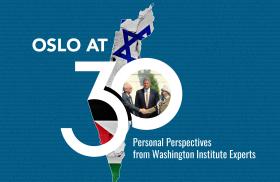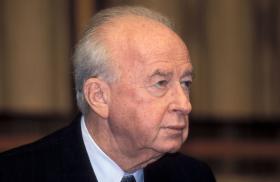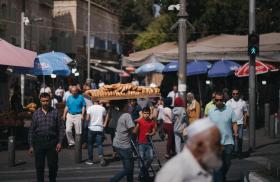- Policy Analysis
- Policy Notes 140
The Palestinian Authority Thirty Years After Oslo
Part of a series: Oslo at 30
or see Part 1: Oslo at 30: Personal Perspectives from Washington Institute Scholars A Compendium
Deep systemic reforms and a credible successor to Mahmoud Abbas could help secure Palestinian as well as Israeli interests.
As Palestinians and Israelis mark the thirtieth anniversary of the Oslo Accords, it is worth pausing to examine what remains of the original promise contained in the agreement (hint: something does remain). More than that, it is worth examining whether those remnants can survive the many challenges facing the Palestinian Authority, especially those likely to emerge “the day after” President Mahmoud Abbas exits the stage.
The PA’s Struggles
For many years now—particularly the past decade—the PA has been a foundering institution, with Abbas bearing ultimate responsibility for its failure to realize a Palestinian state within the 1967 Arab-Israel ceasefire lines. Abbas has led the PA since 2005 and can take credit for presiding over relative stability in the West Bank and preventing a rise in terrorism after the second intifada (2000–04). Yet given his advanced age, he may at any moment leave his post without claim to a worthy legacy. Moreover, he has failed to gain consensus for his nonviolent approach, which has drawn persistent challenges from the PA’s Gaza-based rival Hamas, long an advocate of armed struggle.
Israel has played its own role in weakening Abbas and the PA, in part by enlisting them as counterterrorism “subcontractors” (according to the Palestinian public) in portions of the West Bank, thus eroding the PA’s legitimacy with local residents. In return, the Palestinian leadership has sought a lasting political arrangement with Israel. Yet the political horizon has dimmed over the past decade, replaced by a series of economic and civil benefits, with Abbas missing key opportunities to make progress on the political front.
More broadly, Israeli strategy since 1993 has entailed a shift from pursuing an arrangement with the PA to taking actions that are inadvertently conducive to its collapse, despite such an outcome not being in Israel’s interests. This shift has been especially jarring in light of Israel’s concomitant move toward accommodation with Hamas, precipitated by the 2018–19 “Great March of Return” protests along the Gaza-Israel boundary. Israel enacted this change by directing funds to Gaza and substantially easing the blockade surrounding the territory (see the PDF for a detailed explanation of this development). In effect, Israel’s policy in Gaza is designed to buy time until the Palestinian political scene changes, whether through the PA’s reentry to that territory, a popular uprising by Gazans, or even moderation by Hamas. The policy also aims to prevent a humanitarian crisis—a goal it has achieved, but at the expense of strengthening Hamas. In the zero-sum game played by Hamas and Abbas’s Fatah alliance, any emboldening of the former reflects a PA failure.
To be sure, the Gaza problem does not lend itself to easy solutions, and the likelihood of Hamas moderating is low, even if the group does show pragmatism from time to time. The associated tactical challenge for Israel is securing the Gaza frontier and preventing Hamas from sending arms to other theaters, especially the West Bank. This will require a strong PA that cooperates with Israel and shares a common attitude regarding Hamas.
Trends in Palestinian Public Opinion
In the West Bank, the PA’s weakness derives not only from Israeli obstruction and the absence of a political horizon, but also from manifold internal failures, including political stagnation, flawed governance, widespread corruption, an aversion to self-criticism, inadequate provision of public services, and a narrowing of Abbas’s circle of advisors, which has sidelined the best Palestinian political minds. Discontent has thus surged in the Palestinian “street” and within the Fatah movement, which constitutes the PA’s backbone.
Surveys conducted in March and July 2023 indicate a significant decline in public support for Abbas and the PA, and a corresponding increase in identification with terrorist attacks and their perpetrators. According to the March poll, 60% of West Bank respondents see the PA as a burden and 49% favor dismantling it, whereas only 27% see it as an achievement. The July poll indicates that 67% of West Bank respondents believe an intifada will erupt in the West Bank by the end of 2023. In addition, only 40% reject a statement suggesting that Palestinians should initiate an intifada and that they regard armed struggle as a top priority. Two decades after the second intifada, the failure of that uprising appears to haunt middle-age Palestinians.
However pronounced the public’s dissatisfaction may be with Abbas and the PA’s performance, it has not resulted in widespread protests or a significant increase in support for Hamas. According to the March poll, 51% of West Bank respondents believe that neither the PA nor Hamas deserves to represent the Palestinians. Moreover, past experience shows that in the West Bank, public identification with the use of violence against Israel does not necessarily translate into actual public mobilization to promote terrorism. This is important given the influence of Palestinian public behavior on security in the West Bank. Across Abbas’s two decades in power, the public has generally refrained from actions on the level of an intifada and instead engaged in more limited protests. According to the July survey, 53% of West Bank respondents view the lack of “big street demonstrations” as a positive thing, and 49% disagree with the statement that the PA should stop security coordination with Israel “no matter what.”
Such stances have endured despite repeated Israeli military operations in Gaza, political actions that most Palestinians deem objectionable (e.g., moving the U.S. embassy from Tel Aviv to Jerusalem; signing the Abraham Accords with Arab states), perceived religious offenses in Jerusalem (e.g., a far-right politician ascending the Temple Mount/al-Haram al-Sharif; the Israel Defense Forces entering al-Aqsa Mosque), and other challenges. Relative Palestinian toleration of the status quo may reflect a desire to preserve the fabric of daily life and personal security. Even as the above poll results hint at a sense of irresolution regarding the second intifada, the failure of that uprising evidently forged a profound risk-aversion among some portion of Palestinians. No less crucial is their dependence on Israel’s economy, with many Palestinians employed across the 1967 lines, others working in Israeli settlements, and still others employed at Israeli manufacturing plants in the West Bank.
Further explaining the West Bank’s relatively low enthusiasm for violence is the absence of a viable leadership alternative or system that could realistically replace the current one. Much of the public therefore grudgingly accepts the status quo, granting Abbas and the PA what might be called “negative legitimacy” and the associated room to exercise action and control. But this legitimacy is fragile, as will be discussed below.
Financial and Security Challenges
One cause of the PA’s weakness is the pervasive financial stress under which it operates. Thirty years after the Oslo Accords, the PA still depends on Israel’s economy and lacks engines of growth, while its debt stands at $3.3 billion. In addition to bank debts, it owes $4.7 billion to various suppliers and $400 million to the Israel Electric Corporation. The latter debt periodically leads to power cuts in the West Bank, harming both the Palestinian economy and citizenry.
The PA has taken dramatic steps to reduce these deficits, but the improvements have come at the short-term cost of compromising its capabilities and the welfare of citizens. Since December 2021, for example, it has been paying reduced salaries (75–80% of normal pay, sometimes with additions) to government employees who earn more than $500 per month, which affects the vast majority of the PA’s nearly 150,000 workers. Salary increases have also been frozen for nearly a year.
In addition, the PA has made significant cuts to the budgets of various ministries, diminishing the services they provide to citizens. The West Bank economy has made nominal gains in terms of GDP, unemployment, and foreign trade, but these benefits have not substantially improved daily life for most citizens. Meanwhile, the cost of living jumped by 4.6%, the consumer price index rose by 3.74% in 2022 (the sharpest spike in about a decade, partly reflecting a global rise in inflation but increasing at a much quicker rate than seen elsewhere), and international organizations such as the UN Relief and Works Agency reduced their activity in the West Bank, especially in refugee camps.
Personal security, a primary concern for Palestinians, has likewise come under threat. Israel’s intensive counterterrorism activity in the West Bank has resulted in many casualties this year: 181 Palestinians have been killed there as of August 2023, compared with 151 in all of 2022 and 79 in 2021. Further insecurity derives from the growing friction between Palestinians and Jewish settlers in the West Bank, triggered by everything from struggles over grazing rights to a rise in terrorist incidents from both sides, including revenge attacks. Whatever the outcome, no one doubts that certain Israeli political elements back the extremist portion of the Jewish settler community.
The PA’s vulnerability is also reflected in the conduct of its security apparatus, its central arm for maintaining governance and stability. PA security forces have always suffered from basic shortcomings such as limited resources, problems with officer hiring practices, failure to bring cases to resolution after arrests, and a reluctance to deal with rogue elements of the Fatah Tanzim paramilitary forces. True, they have largely fulfilled their official mandate over the years, growing more professional and helping anchor the PA even in preparation for the day after Abbas. Yet the situation has worsened since 2021 due to budgetary stressors and fraying public legitimacy. Overall PA governance and control have lagged as a result, with pockets of anarchy forming in peripheral areas, especially refugee camps in the northern West Bank. Indeed, data shows that since the beginning of 2023, 119 of the 174 significant Palestinian-initiated attacks originating in the West Bank came from the north.
New Palestinian Resistance
A lack of political, social, and economic mobility in the West Bank has prompted relatively small groups of young adults—mostly under twenty-seven years of age, below which Palestinian workers are not permitted to enter Israel—to effectively declare independence from the PA. Operating in areas where the PA is effectively absent, these groups have consolidated their military power under a “No Fatah, No Hamas” banner, with the goal of defending their homeland from Israel. Such elements are challenging the PA’s political center along with its agenda and enforcement agencies.
This new generation of Palestinian resisters is more sophisticated than those of the past decade, who were largely limited to “lone wolf ” actions (e.g., suicide attacks) and often used simple weapons such as knives. Many of today’s young militants have better weapons and are more focused on improving their military capabilities and using social media platforms to expand their influence. To the PA’s discredit, some of these individuals are former Fatah or Tanzim members who were once regarded as the movement’s flesh and blood.
Added to the mix are Hamas, Palestinian Islamic Jihad, and similar actors who have long sought to convert the West Bank into a battleground for anti-Israel resistance. Hamas continues to direct its operatives to promote terrorist attacks under the general principle of seeking escalation in the West Bank versus quiet in Gaza. Local actors—especially in the northern West Bank but also in the south—have demonstrated a willingness to cooperate instrumentally with more established organizations and conduct higher-level attacks such as car bombings, rocket strikes, and drone operations. This activity is often backed by Iran and Lebanese Hezbollah, who have flooded the territory with know-how, weapons, and money. Accordingly, some observers worry about the long-term potential for a so-called “Command Day,” when disparate anti-Israel groups would hypothetically join forces and attempt to seize control in all of the territories. Any multifront challenge of this sort could be more difficult for Israel to fend off.
Conclusion
In the three decades since Oslo, a litany of crises has eroded public trust in the very idea of conducting political dialogue in the spirit of those accords, including two Palestinian intifadas, the fallout from Israel’s 2005 Gaza disengagement, and even the 2006 Lebanon war. A real window opened during Prime Minister Ehud Olmert’s tenure in 2006–08, but it eventually closed as well, whether because of Israeli politics or Abbas’s hesitation.
Today, the PA has survived to carry out its work in the civilian, economic, and political spheres. But its inherent weaknesses have grown starker, and the West Bank governance system is eroding both ideologically and functionally as a result of political dormancy, distrust from the Palestinian street, and the crowding of the resistance space. This year has already been the most violent under Abbas’s tenure—as noted above, 181 Palestinians have been killed by Israeli forces in the West Bank since January, while 30 Israelis and foreigners have been killed by Palestinian attackers from that territory and East Jerusalem. The dysfunction and violence have raised questions about the PA’s ability to navigate future crises, including the day after Abbas leaves the scene.
His potential successors are aware of this reality and the need to offer an alternative approach, including the formulation of national goals that help ensure the PA’s viability. From Israel’s perspective, their current options are not very encouraging. They include pursuing a political alliance with Hamas, returning to a strategy of popular violence and terrorism, and—in the worst case—abandoning the two-state goal in favor of “one state for two peoples.” Because Israel prefers to have a single “address” for managing issues in the West Bank, it has long feared a PA collapse and has repeatedly taken actions to keep the institution functioning. These crutches—usually in the form of economic relief—have allowed the PA to hobble from one crisis to the next, without having to address the underlying problems causing ever-widening fractures. Economic initiatives alone are insufficient to empower the PA to create a conceptual framework that rebuilds a sense of national unity or facilitates a post-Abbas succession plan.
While Abbas is still in power, Israel has a vital interest in making a good-faith effort to facilitate the rise of effective and legitimate leadership for the Palestinian public. Such an outcome would benefit both sides; waiting for Abbas’s demise will almost certainly be too late. Failure to focus on this pressing need now may produce a far more problematic scenario in the future, forcing Israel to deal with multiple “addresses” of power and authority or perhaps even administer the affairs of the West Bank population itself, with all the political challenges, financial costs, administrative headaches, and international diplomatic opprobrium that scenario would bring.
To help revitalize the PA, Israel can focus on a “state in the making” concept, which would include strengthening a multidimensional leadership responsible for the economy, welfare, health, and security of Palestinians in the West Bank. Rehabilitating the PA’s internal legitimacy also requires Israel to avoid further West Bank settlement construction, refrain from additional land confiscation, and forcefully confront terrorism by radical elements within the Jewish settler community. Such moves would necessarily be paired with a firm demand that the PA implement deep structural reforms in its institutions, agencies, and security sector. Successful rehabilitation that prevents PA collapse could give wavering elements of the population reason to distance themselves from violent activism, while also better preparing the PA for future challenges. None of this will be easy—either politically or in terms of implementation—but it is necessary to prevent a total breakdown of security and, potentially, a reversion to the heavy burden of the pre-Oslo era, when Israel bore responsibility for the daily lives of all Palestinians in the West Bank.
These recommendations aside, the unsettling question persists: why, thirty years after Oslo, has the diplomatic track gone so quiet? And why has Abbas, an architect of the Oslo paradigm, failed to establish a Palestinian state in his time? The answer, alas, is complex, relating to the history between the two peoples, interactions between their leaders, and internal developments in each national arena. After successive failures to achieve peace, Abbas may have given up on achieving his vision, settling instead for a (perishable) legacy that boils down to “I did not give up on my principles.” Whatever the case, the prerequisites for any revival of diplomatic progress are clear: courageous leadership, public legitimacy for making difficult decisions, and persistent efforts to undermine opposition forces so they cannot stand in its way.





